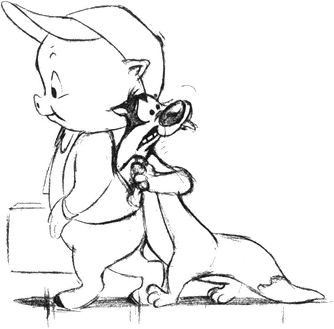Who's in Charge Here?
Chuck Jones remembers, with relish, a story about the New Yorker 's legendary editor Harold Ross. Alexander Woollcott (was it?), reviewing a play, had written a line about laughs so crassly set up "the audience would laugh at the drop of a ha." Ross loved that. But then it occurred to him that all along the chain of transmission, typist to proofreader to typesetter to second proofreader, more, . . . there'd arise besetting temptations to correct "drop of a ha" to "drop of a hat," in response to a "drop / hat" linkage locked into somebody's consciousness.[1] So, block that "t"! If the 't' happened, said Ross, he'd commit suicide. Bigawd, it mustn't happen! In those days the New
[1] It was a realistic worry. On two different occasions I have tried to salute James Joyce as "Playboy of the western word." Both times, someone made a "correction."
Yorker was printed in Chicago. So imagine Ross taking a night flight to Chicago (not by jet, by rickety prop). And, last, envision a master printer coming on scene to marvel at the skinny legs of Harold Ross, protruding from a huge press into which his flashlight-aided eye intrudes to make sure "that damn 't' hasn't been inserted.
Unlikely, yes, especially that last shot. A Looney Tunes scenario, also, yes. "It's great, isn't it?" Chuck Jones exults. "The kind of thing you love and admire in people." Not only for seeing the problem, but for being willing to invest that much energy. "Imagine him getting out at the airport. They'd probably had to stop twice from New York to Chicago in winter time. And then getting down there and seeing to it! Oh, that's great! That's great! That's heroism!"
Yes, Chuck Jones is capable of that order of enthusiasm. The elements of the story, after all, do resemble the elements of a cartoon, frame after laborious frame, conceived and concatenated with the sole intent of rousing an audience (some months in the future, therefore an abstraction at this moment) to a spontaneous "That's great!" It's hard to keep in mind how different is the animator's status from that of the least significant of live comics, any of whom can watch the effect she's having. Commentators have noted that the first Road Runner cartoon, Fast and Furry-ous (1949), waited three years to be followed by the second one, Beep, Beep (1952). Jones remembers thinking resignedly that Fast and Furry-ous might end up a one-shot (no more reuse of those characters, that situation). Sequels could be spurred by feedback, but feedback was slow. "We weren't allowed to preview our films [here "preview" means attending a first theater showing] because the producer would've had to take us out to dinner, which would've cost maybe $15. So he didn't, and we never
got to them. A good thing, because we never got to respond to any audience whatsoever."
A good thing?
"Yes. There were no critics. And we had nothing to respond to except ourselves. From when we started a picture to when it hit the theaters and we began to hear about it, that was apt to be about three years.[2] By that time, each of us directors had made, oh, thirty more cartoons. So we could hardly respond to even the exhibitor."
Responding to the exhibitor—that would have been where the rubber met the road. There was, let us be grateful, no such response when One Froggy Evening premiered in 1955. ("Thank God," says Jones; "I couldn't figure out how to do another.")
As to how he did the only one, though: I remembered from when I was a kid. Any boy that's ever picked up a frog knows how the body sits and the limbs hang down. So we had to be certain, in those first few seconds on the screen, that when the guy appeared he looked like a frog. Even that his eyes blinked upward." ("Guy"—that's interesting usage; not a green frog, whom you don't refer to as "guy"; no, some human virtuoso who resembles a green frog. Quite as Porky is best thought of as a fat fellow who happens to resemble a pig.)
And that a frog blinks by flicking his lower lid upward is one of the many esoterica Chuck Jones recalls picking up from his reading. So the frog in the film blinks, correctly, down-to-up, once, and quite early; whereafter his eyes do nothing so remarkable again.
[2] Another effect of this time-lag was that Termite Terracers tried to avoid topical gags that might be incomprehensible three years down the road. That's one reason their creations stand up so well after four decades.
And the frog's legs: I don't know if it would make any difference, but it was chicken legs. Very skinny chicken legs." (That means, animators learned to move one critter's legs by attending to a different critter's. Do not be scandalized. They work that way all the time.) "But the real problem was keeping anybody from sampling his performance except the moviegoers and the man who 'owned' him and his voice." The Voice—that was a voice that could encompass any range, with dances and gestures to match. Our frog commands the span from Ray Charles to Pavarotti. And no one can see his performances save their victim, the man who has been ruined by his trust that a performing frog's promoter can't help getting rich. Keeping anyone else (except us) from hearing the frog's cantati is a feat achieved by all manner of closed doors, dropped curtains, interposed windows. That is the film Time 's Jay Cocks said came as near to perfection as animation ever has.
Jones gets a little inarticulate in its vicinity. I don't know of any way to express it except by saying there are only two things that count. One is the love you have for what you do, and the other is the work you're willing to devote to achieve it." And when it's finished only the love should show. "If the work shows, you're in trouble. Roger Rabbit, the only thing that showed was the work. But the love was nonexistent."
Another thing he says is more arresting. "My characters," he'll often remark, "are aspects of me." Thus (his most frequent example) the amorous skunk Pepé Le Pew is the irresistible Lothario our Spokane-born Chuck Jones would have longed to be. Likewise, Wile E. Coyote projects what our 1912-born Chuck Jones perceives as his own incompetence in managing any gadgetry whatsoever. But: (and I can still hear
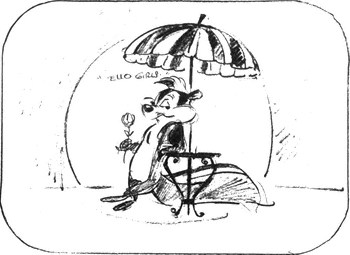
his intonations after two decades) "What part of me is the green frog? "
Let's suggest. The Green Frog looks like nothing; but, Lord, he can perform! Frog 1: The frog as he may imagine we see him, a commonplace croaker. Click! Frog 2, the inner, pulsing Frog! (The Chuck Jones who would marry, successively, two talented and beautiful wives?) Or, Frog 1, a mere frog, as a videocam might pick him up: in a human context, something worth little attention. Click! Frog 2, a Frog transcended by animation! (And compare what Mickey did for the mere mouse.)
No, neither is animation all self-portraiture, nor is it all the foregrounding of a medium, not even of a medium undreamed of before this century. It is, like all art, the trace of a man doing an intricate job he could not have wholly described to us. (To reach for the very top: what might Shakespeare have said of Hamlet? Oh, a script the company needed, with a fat part for Burbage. Or Botticelli of the Venus? Ah, a decoration some Medici had a whim for. Botticelli, by the way, like most painters of his era, was attended by the likes of in-betweeners: apprentices who'd attend to such trivia as robes and clouds.)
—A Thought Experiment, meant not to smuggle Chuck into exalted company; no, simply to adduce the fact that Art has normally been commissioned by folk, or by forces like the Brothers Warner, who'd had no way to guess what might later be made of it. Did Homer's tribal hearers envision a Harvard classroom? Or even the discipleship of Roman Vergil?
Of course not. Nor did hundreds of thousands of viewers of Jones cartoons—who'd never heard of Chuck Jones—ever imagine the "Joneses" disengaged from the "Frelengs" and the "McKimsons" for separate contemplation, let alone serious discussion. Those viewers saw a Warner Bros. cartoon when they happened to visit a movie-house that was showing one, and it was unlikely to have been for the cartoon that they'd paid that visit. In those gone times the Cartoon and the Newsreel and the Short were merely french fries that got served in a two-hour package with the feature. (Likewise, a recitation of a new chunk of the Æneid was something you might have put up with when your business was an audience with the Emperor Augustus.)
It's important, therefore, to glimpse both how slight and how inclusive a claim we make when we adduce other arts in
other times. In most times and places what we've come to call "art" was created to satisfy some market. Also, it was brought into being according to procedures which could be articulated, taught, learnt. There were masters, and apprentices aspiring to be masters. How many people worked on the Sistine Ceiling? We think of Michelangelo; but he'd have had helpers. They were learning to do what he did, much as In-betweeners learn to Animate and perhaps aspire to Direct.
But Renaissance painting is only a partial analogy for studio animation. The nearest full analogy for that seems to be Wagnerian opera, which requires expert set-designers, virtuosos of lighting, voice-coaches, scene-changers, costumers, nowadays experts at getting the unobtrusive microphone into the right place, even someone adept at comforting a sulky bassoon. Likewise, as we've seen, Chuck Jones's concentration on timing and expression, his complementarity with animators of the quality of Harris, Washam, and Levi-tow, needed further complementing by Maltese (story), Noble (layouts), Stalling (music), Blanc (voices) . . . and more and more and more, clear down to the ink-and-paint women whose deft hands made the eels the camera saw, and the man at the camera, who might need to know how to slide a foreground eel leftward faster than a central cel which slid faster than the background ("I've used as many as three layers for certain effects," says Jones) just to get, on a Warner budget, the kind of shifting-perspective look they were used to getting over at Disney with the megabuck Multiplane camera.[3] And that inventory omits, among other skills, the bizarre
[3] True, at Warners they weren't getting differential focus, the plane of emphasis sharp, other planes fuzzed. Which also means they weren't getting an attention-distractor, which, alas, describes much of what Disney spent money on.
skills of Treg Brown, than whom no one was more resourceful at making the ear hear what the eye wasn't seeing. "When the Coyote got his foot caught in the line attached to a harpoon and was dragged willy-nilly across the desert floor over cacti, under boulders, bumping and slapping every obstacle possible, never once did Treg supply a logical sound effect: flying springs, breaking bottles, small explosives, human ouch'es and oof's, popping balloons, railroad crossing bells, and so on." That was Zoom and Bored (1957), where things went too fast for an audience to ever quite realize it couldn't possibly be hearing what it was seeing. Nor did Treg need arrays of equipment; with merely a newspaper he could create the sound of "any kind of fire from bon- to forest to rocket."[4] Imagine a recording session at Termite Terrace. No, it's not a sane milieu we're hinting at.
Understandably, even principal characters, the only studio properties to command an audience's awareness, developed mild cases of multiple personality. Bugs Bunny evolved out of a collective uncertainty, "moving from director to director, picking up and dropping comic turns and comedic characteristics of possible use to the mature character. But none of this was deliberate. We not only didn't know that there was a comic genius brewing in our group, we didn't even know we were pregnant."[5] The famous name, even, was accidental. In 1938, when almost the only well-defined Termite Terrace character was Porky Pig, a director who answered to Bugs Hardaway, though his formal name was Ben, thought a rabbit might play nicely opposite Porky, and commissioned one from the resident character designer. The designer, a Disney alumnus named Charles Thorson, sent back a model sheet
[4] Chuck Amuck, p. 191.
[5] Chuck Amuck, p. 195.
headed "Bugs' bunny." ("Had it been for me," Jones remarks, "it would have been 'Chuck's bunny.' " Also the label would have been forgotten. Who it was had the genius to perceive the fitness of "Bugs" no one seems to remember.) Hardaway's film, Porky's Hare Hunt, featured a rounded nervous rabbit, crouched, always ready to leap for an exit; but "the Bugs that evolved," Chuck Jones remarks, "stood upright, a guy who's not going to go anyplace—sure of himself."[6] The Hardaway Bugs, though, did utter one enduring line: "Of course you realize this means war." As 1938 audiences would have known, it's a steal from Groucho Marx.
A Wild Hare (1940) was Tex Avery's consolidation. Not only have we for the first time Elmer Fudd's "Be vewy, vewy quiet, I'm hunting wabbits!" and Bugs's sharp "What's up, Doc?" we have also, as Friz Freleng remembers, something utterly new: "A rabbit so cocky that he wasn't afraid of a guy with a gun who was hunting him." All connection with timidity, with cuteness, is severed. And here's a moment to remark that Warner Bros. features, such as drew audiences to the theaters where Warner Bros. cartoons were shown, were (in Chuck Jones's words) "gentle pictures like Little Caesar, I Was a Fugitive from a Chain Gang, Dr. Ehrlich's Magic Bullet ." They starred the likes of Humphrey Bogart, James Cagney, George Raft. Their visual style featured murk and mist and fast cutting between short violent scenes. That was no milieu at all for a cute bunny, and by 1946 (in Freleng's Racketeer Rabbit ) Bugs was reducing to panic co-stars the likes of Edward G. Robinson. ("Help! Police! Don't leave me with that crazy rabbit! ")[7]
[6] Joe Adamson, Bugs Bunny: Fifty Years and Only One Grey Hare (1990), P. 53.
[7] Adamson, Bugs Bunny , P. 47.
Anyhow, after A Wild Hare "all we had to do" (Jones recalls) "was to follow Tex's lead. The only problem was, none of us knew or could figure out what Tex had done right. Including Tex." Bugs might have settled into a personality derived from Harpo and Groucho—alternately the knowing innocent and the slinger of zingers—had Avery not left for MGM, leaving Freleng and Jones and McKimson and Clampett to reflect that the Bunny they had at Warners was "gradually becoming a more complex character" which it behooved them to shape. That's sensitive in divining that though Bugs had no visible or commercial existence save as they drew him and timed him, still it was important—hence meaningful—to think of a Bugs whose autonomy they were obliged to respect.[8] "Bugs went through a period of wild awkwardness before settling into the self-contained studied attitudes peculiar to him, so that his every movement is Bugs and Bugs only, just as his speech developed from a kind of vaudevillian patois loaded with 'deses' and 'doses' to a fully cadenced speech in which he studiously inserts an occasional 'ain't' in the same casual way as an Oxford graduate does.[9] In sum, "We discovered the enormous difference between being crazy—as in A Wild Hare —and playing at being crazy.
This goes deep; I'll permit myself two more paragraphs of quotation: "In short, all fat had to be removed from his dialogue, his figure, and his behavior. We were, in volleying Bugs back and forth from director to director, developing the heart and muscles of a mature and believable character.
[8] Chuck Jones recalls a child correcting her father: "Mr. Jones doesn't draw Bugs Bunny. He draws pictures of Bugs Bunny."
[9] Chuck Amuck, pp. 199–200. (A clarification: when Avery left Warners, McKimson was an animator there, not yet a director.)
"I think we all would have been embarrassed if one of us had tried to state what was happening in philosophical or logical terms. Logic and philosophy were certainly there, underlying the growth of our characters. But we were shy of pontification as well as of aesthetic theorizing or critique. Only in retrospect can we see that there was a deep and innocent knowledge forming within this heterogeneous and varied crew, and that knowledge produced the atmosphere for all the other characters who grew to maturity during those same years, between 1941 and 1950, and beyond. During those years we learned what was funny without analyzing why it was funny, and, even more important, what was not funny."
That last sentence is tricky. Does "learned" govern the two "what" clauses—we learned what was funny and what wasn't? Or does "what was not funny" go with "why it [what was funny] was funny," as one of a contrasting pair we learned not to analyze? That's worth spelling out just to indicate that we've somehow wandered into a semantic forest. How to talk about characters who never "really" existed, like Bugs or Achilles, characters moreover who cannot be assigned to a sole inventing intelligence such as Shakespeare's, is a question lit crit doesn't know how to confront. And what's to be done with the undeniable fact that Bugs—say—although the property of millions of viewers, was also the creation of (at a simplification) at least four directors, all of whom used somewhat different model sheets and had somewhat different conceptions of who Bugs would be if he were human (though stubbornly, he'd remain a penciled rabbit)?
Jones is explicit about the origin of his personal Bugs. I could not animate a character I could laugh at but could not understand. A wild wild hare was not for me; what I needed was a character with the spicy, somewhat erudite introspec-
tion of a Professor Higgins, who, when nettled or threatened, would respond with the swagger of D'Artagnan as played by Errol Flynn, with the articulate quick-wittedness of Dorothy Parker—in other words, the Rabbit of My Dreams."
Such a Bugs—and note how literary are the analogies—"is far too strong a character to behave as an early Daffy Duck or a late Woody Woodpecker acts. It is no part of his character to go out and bedevil anyone for mischiefs's sake alone."
Hence: "Golden Rule . Bugs must always be provoked."[10]
Jones makes his case for rule-based comedy in the tenth, or Road Runner, chapter of Chuck Amuck, where he quotes Groucho Marx: "Comedy is not so much what you do, as what you don't do." Rules itemize the impermissibilities. On page 225 he lists "some of the rules" for the Coyote-Road Runner series (forty-two films at least: between four and five hours of screen time). They include: "No outside force can harm the Coyote—only his own ineptitude or the failure of the Acme products," and "No dialogue ever, except 'Beep-Beep!' " and "Whenever possible, make gravity the Coyote's greatest enemy." It's also specified that the Coyote could stop any time—if he were not a fanatic. To this, Santayana's definition of the Fanatic is appended: One who redoubles his effort, having forgotten his aim. For it's clear, Jones points out, that after the first couple of films the Coyote has utterly forgotten that his quest concerned something to eat. George Santayana was a genial philosopher who'd have been tickled to know that in The Life of Reason (1905–6) he'd inscribed a formula for an obsessed coyote.[11]
[10] Chuck Amuck, P. 211.
[11] The exact quotation: "Fanaticism consists in redoubling your efforts when you have forgotten your aim." As usual, Jones relies on memory to preserve the gist.
And why transfer that maxim to a faux animal kingdom? Because (1) what can easily be done in live action, such as human behavior, is specifically not the domain of animation; (2) "It is easier to humanize animals than it is to humanize humans," a dark saying philosophers would be rotating endlessly had they received it from a sixteenth-century Mon-taigne instead of from a Spokane-born movie-maker whose specialties have included mock-coyotes, mock-rabbits, mock-ducks.[12] Maxim 1 is specifically where a Termite Terracer peels away from Disney assumptions. As we've already suggested, "the illusion of life" was a slogan that loaded the huge Disney enterprise with dead ends: immense sums squandered on making the "humans" in Cinderella (1950) and Sleeping Beauty (1959) look as if live actors had been filmed, as they likely should have been. If you're animating, then take pencil in hand and animate! Don't restrict yourself to what a clicky-click tripod-supported optical eavesdropper might have picked up without even thinking (because it can't think) about trying.
The Road Runner saga, all four-plus hours of it, relies on just one theme, seemingly inexhaustible. That is Wile E. Coyote's persistence in pursuit of what was once a potential snack and has long since mutated into an ideal conquest. The viewer of a new installment has seen all of it before and yet seen none of it before. The setting is always an idealized American southwest, paradise of bluffs and canyons and vast spaces. Trucks or freight trains intrude sparingly, their human denizens never visible. Also mail brings wares of the Acme Company, which invariably malfunction. (But not grossly; no, subtly. The defect that sends the Coyote yet one
[12] For details see Chuck Amuck, pp. 227–9.
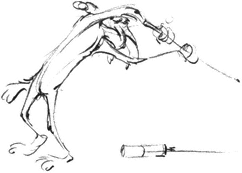
more time off the cliff is as minute as the programming error that can cost NASA yet another satellite.) And the fall off the cliff is so ritualized there is even a ritual explosion, a chemical madness of flame and orange clouds. That's especially evident in view of the normal Jones-Noble policy of reusing nothing.
So spare were the resources, so scant the need for normal chores such as designing new settings, that when What's Opera, Doc?, the most visually ambitious of all the studio's thousand-odd shorts, was estimated at seven weeks' drawing and shooting time instead of the normal five—104 separate "shots" as against the usual 60-odd—it was sandwiched be-
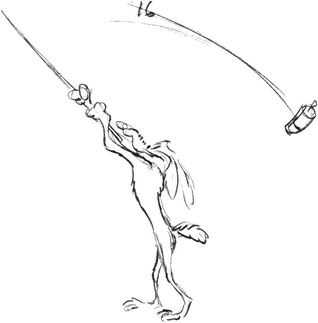
tween a pair of Road Runners which could be brought off in four weeks apiece. On the time-sheets that went to Accounting, the total of fifteen weeks was allotted evenly.
Men continually learning to do what they were doing—that's not a bad way to describe an animation crew in those golden years. And a reflexive look at what they were learning to do—that helps account for Duck Amuck (1953), which is also indebted to Sherlock Jr . (1924): Buster Keaton playing a projectionist who wanders down the movie-house aisle and into the movie he's projecting. There he becomes "the immediate victim of whatever way the scenes happen to be cut. As he sets foot in the living room, the scene cuts and instantly he is outside at the entrance door. He knocks—cut—and then falls off the steps. The steps have disappeared. He is now in a garden."[13]
You get the idea. Daffy Duck, unlike Buster, got it too, and it roused him to mounting levels of indignation. As far as Keaton could tell, his problem was simply with The Way Things Were; hence his look of dreamy bemusement. Daffy's though, was with an enemy he could get mad at: an Animator, an omnipotence whose eraser destroyed each set for which Daffy was costumed, and whose paintbrush again and again brought into being, as easily as in the Book of Genesis, a world for which Daffy was totally unequipped.
To think of Keaton is to remember Chaplin, who was, as it seems easy to overlook, a wholly different kind of artist. Chaplin was a great performer, whose performance the camera observed, chin leaning on palm. Any glitch in the performance it simply recorded, occasionally, if rarely, to Chaplin's regret. In The Great Dictator Hitler, as impersonated by Chap-
[13] Rudi Blesh, Keaton (1966), pp. 245–6.
lin, confronts a saluting fanatic who proceeds to demonstrate his contribution to the Cause by somersaulting backward out of an upper window. A parachute, clearly? A rocket motor? But we never see the fanatic again. We see Chaplin, straining forward, and further forward, and then turning to his chief of staff: "Why do you waste my time with things like this?" Early in 1964 Chaplin was pleased when a guest remembered that sequence. But then he said, "I did that in three moves. I think I held the second one a little too long."[14] An actor at ease with cinema technology, as Chaplin never was, would simply have relayed an instruction to the editor.
Keaton by contrast was a great collaborator with the whole art of cinema, fascinated by what he and visual technology could achieve in concert. There's a famous scene in The Playhouse (1921) which presents him as the entire orchestra—fiddler, cellist, bassist, clarinetist, trombonist, drummer. And he's also the stagehand who lifts the curtain, and (in one shot) all nine blackface minstrels, and, yes, every single member of the audience. That is not Chaplin's way of thinking. Rudi Blesh helps bring home a pertinence to Duck Amuck: "A song-and-dance team . . . rushing on from opposite wings, racing through a unison cane dance, bowing and exiting. . . . An invisible hand erases them as if they were animated cartoons."[15]
The Invisible Hand—that's the theme Chuck Jones picked up, not necessarily from Keaton's Playhouse but from its vicinity. So Daffy rails like Job against his creator, who
[14] The place was Vevey, Switzerland, and I was the guest, with, among others, Bill Buckley and James Mason. Charlie's unease with cinema technology became clear when he explicated what Modern Times was really about: actors entrapped amid miseries over microphone placement.
[15] Blesh, Keaton, p. 165.
proves to be Bugs Bunny (the film's last spoken words come from Bugs: "Ain't I a stinker?"). Chaplin had no "creator." In Chaplin's fierce ego it was Chaplin who was solely responsible for the visible universe.
Duck Amuck is brutal in its presentation of what it's "about." Duck Amuck is about whatever is begotten, born and dies at the flick of an eraser-tipped drawing implement. It's Daffy's anguish that he can have no other existence. Correction—he also exists on the screen, frame by frame, hence between black upper and lower framing lines which in Duck Amuck have a way of sagging under him or collapsing atop him. Pushing a soggy upper line upward, he's The Prisoner of Termite Terrace, just winning himself some Lebensraum . He's also acknowledging that he's close to extinction, a fate that will happen if that heavy top line caves in. (It won't, it won't, even as we squirm in our seats we know it won't. Shouldering the sagging frame-line, Daffy impersonates the Dutch boy's finger in the dyke.)
Duck Amuck, Chuck Jones recalls in Chuck Amuck, was unusual in being a director's solo creation. It "happened almost exclusively on the drawing board as I drew, laid out, the key character poses and wrote the dialogue. Monologue actually, since Daffy's was the only voice heard. Mike [Maltese] worked at my shoulder on this one, rather than on a storyboard. From the first scene, when Daffy leaps out, saber in hand, shouting 'Stand back, Musketeers—they shall sample my blade,' to the penultimate . . . scene, where Daffy is shouting in absolute frustration, 'Who are you; I demand that you show yourself!!' he has been in conflict with the animator who is drawing him—in a word: me."[16] So for an ending
[16] Chunk Amuck, p. 171.
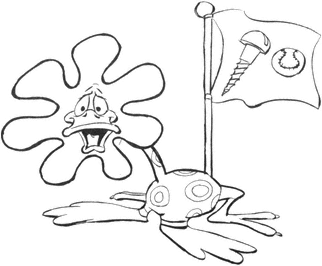
Jones had to mutate into the sole person in the world "who had known equal conflict with Daffy Duck"—and that person was Bugs Bunny. When you remember that the Termite studio was a community alike of characters and of creators, that's perfect studio logic.
It should be added that at one moment Daffy is even deconstructed, into a quadruped with green front legs and black hind ones, its polka-dotted torso equipped with a flagpole tail and garnished with a seven-petalled purple daisy surrounding a beak which is uttering desperate words: "It isn't as though I haven't lived up to my contract . . . goodneth knows I've done that . . ." This Daffy has no integrity whatever, save (1) the animator's whim, mixed with (2) a sole principle, which is, "Anything to Survive."
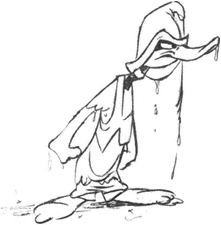
Robin Hood Daffy
And had any Daffy any higher theme? It depends on who you ask. But no, not the Jones Daffy. The Jones Daffy "rushes in and fears to tread at the same time," which makes him, by the standards of Alexander Pope, simultaneously Fool and Angel. Also, he deems Honesty the Best Policy—"when everything else fails." For, "To desire, in Daffy's rationale, is to need—as it was to me at six; to need is to acquire, and acquisition is the essence of living."[17]
So we're back to Chuck Jones, age six, as a clue to Daffy, an intricate being who shares little save size and shape with the Disney Donald. The latter has after all no notable character beyond a propensity for tantrums. "Character" wasn't re-
[17] Chuck Amuck, pp. 239–40, where we also find "Cowardice is its own reward."
ally a Disney strength. Mickey, Minnie, Donald, Pluto—their identity is chiefly visual. Of the Seven Dwarfs, Doc and Grumpy and Dopey may claim character; Happy, Sleepy, Sneezy and Bashful exhibit mannerisms. But the rule-based Termite Terrace identities, those were creations with something—yes, granted, just a little, but something —in common with the likes of Hamlet. For (1) there were things they would or wouldn't do, and (2) what they would do, when they did it, they did with a style we take pleasure in identifying, a style of moving and talking that's continuous with their look. Reflect that though Donald Duck is white and wears a sailor jacket, Daffy is black and naked and—what? "Neurotic" is a forceless word to set against Daffy's id-like reserves of energy. "Thurvival of the fittest! . . . and besides . . . it's fun!"—that's his idiot screech once he thinks he's arranged for Elmer Fudd to shoot Bugs Bunny (Rabbit Fire, 1951). What makes the next bit work is Bugs's contemplative calm: "(Bites . . . crunch, crunch, crunch ) (Mouth full ) Say, Doc (chew, chew ) are you tryin' to get yourself in trouble with the law? This ain't wabbit-huntin' season . . ." No, it's duck -hunting season, something Daffy is quick to call "an inmitigated frabication." We can hear his nerve crumbling, though after a frenzied set of exchanges he attempts to take charge, with these fateful words: "I say it's duck season and I say Fire!! " In the next frame his bill has somehow been (as the dialogue sheet notes) "blown askew," a mild phrase for its new geometry. It's like him, to get so caught up in the vehement rhythm of Duck season! Wabbit season! that he gives the order to Fire!! just one luckless step out of phase.[18] And it's like
[18] Chuck Amuck, p. 131.
Elmer Fudd, to be so scrupulous about matching the victim to the season, once he's satisfied he understands what season it is.
We say "It's like him" about folk we're confident we understand, and the major Termite Terrace characters inspire that order of confidence. Why is that true of Warner Bros. and of no other cartoon studio? Surely it's traceable to the Warner policy of putting a single director in sole charge. That the three directors who might manage Daffy or Bugs in a given season had each of them a slightly different slant seems to have enriched, rather than muddled, the lifelikeness of the characters. And that one of those directors brought to bear on animation as detached, as conceptual a mind as did Charles M. Jones: that unlikely fact has much to do, surely, with the evident superiority, year after year, of the Warner shorts. To risk a stark generalization: after Snow White (1937) had pioneered the animated feature, the Disney shorts are seldom memorable; an exception such as Toot, Whistle, Plunk and Boom (1953) is apt to bear the hallmark of a virtuoso director (here, Ward Kimball). Elsewhere? For thirteen years MGM had the great Tex Avery; after 1940 they also had Hanna and Barbera putting Tom and Jerry through their formulaic wars. Those differ from the Coyote-Road Runner quest in that whereas Wile E. and his quarry exist in different psychic universes—the one obsessed, the other blithe—the Tom-and-Jerry formula calls simply for a cat who'd eat a mouse if only he could manage to catch it; but the mouse, being smaller, hence smarter, can always outmaneuver him. The Road Runner never outmaneuvers the Coyote. He's never even distressed by him. What outdoes the Coyote is the interactiveness of a single coherent universe, where fanaticism is guaranteed to defeat itself. True, that's not such a universe
as defeated Hitler, but it sustains forty-two cohesive six-minute cartoons. And so on and so forth, and do not even mention Woody Woodpecker. No, as Disney short cartoons faded it was Termite Terrace or nothing.
Also, Termite Terrace could build on its own history. It's been noted that when a gunman threatened Jack Benny with "Your money or your life!" and Jack hesitated a countable number of seconds before muttering that he was trying to decide, his hesitation, and the resultant laughter, built on years of establishing a character, Jack the Tightwad. Likewise, by the time of The Merry Wives of Windsor Shakespeare's audiences knew what to expect of Jack Falstaff. Likewise too, by the time of What's opera, Doc? (1957), a masterpiece as The Merry Wives is not, privileged audiences know that when the figure who casts huge shadows on orange cliffs turns out to be Elmer Fudd, they're simultaneously regarding a Fuddy emulation of the demon through whom Fantasia dramatized Mussorgsky's violent music, and watching one more Fuddian attempt at grandiosity (a Heldentenor? spare us), and coping with an inept impersonation of Siegfried, and engaged with yet another episode of "Kill the wabbit!" That's four layers at least; it resembles a piling-up of cels. Much, back in '57, could depend on your neighborhood. If you lived near a theater owned by Warner Bros. you'd likely seen enough Warner cartoons to enjoy the habitué's response; but if your cartoon fare had been chiefly Disney, or Tom and Jerry, then the What's Opera, Doc? you saw was something quite different, brilliant but arbitrary. And when Brünnhilde made an entrance, impersonated by grayfurred Bugs in a Marilyn Monroe pose, a-grin atop a bulky, self-conscious white horse with eye-makeup and a flowered garland, then—But wait! That horse!!
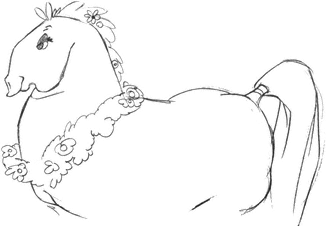
After more than a third of a century Jones is rightly proud of that horse. It's huge, like Wagnerian divas; also white, and rectangular, and smug. Detail by detail it's "beautiful," but the sum of exquisite parts is a cumbersome rectangle. That rectangularity cries out to be dwelt on. The Rectangle bobs to and fro; tiny Legs support and propel it. A smug expression indicates that all aspects of locomotion have been seen to (and Bugs looks confident that he'll not be tossed off). Bugs slides down the horse's back and neck, and, next thing we know, he and Elmer are engaged in a ballet. A ballet! Good grief, a horse that deposits you in a ballet! "Tatiana Riabouchinska and David Lichine were unwitting contributors to the authenticity of this bit of terpsichore," runs an enigmatic caption in Chuck Amuck .[19] It means, Footage of a
[19] Chuck Amuck, p. 207. And the five color illustrations in this spread merit loving study.
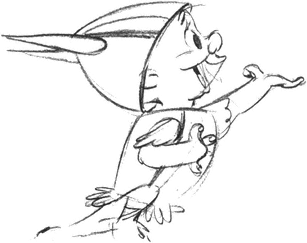
performance of theirs was studied by the animating team. The music heard by viewers of the animation was performed by the Burbank Symphony, which was under instructions to eschew any clowning. The film has 104 "cuts"—i.e., wholly new setups—in just over six minutes. That's about twice the usual count, which helps explain something we've already noticed, billable time filched from adjacent Road Runners.
Whether Wagner's fame can hope for shelter is another question. In 1989, at Northwestern University, a professor of music history informed a survey class of music seniors that this week's subject would be the Ring cycle. All forty students promptly burst into a massive Valkyrie-esque rendition of "Kill the wabbit!"
